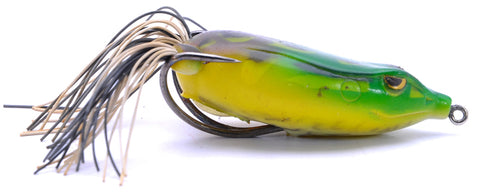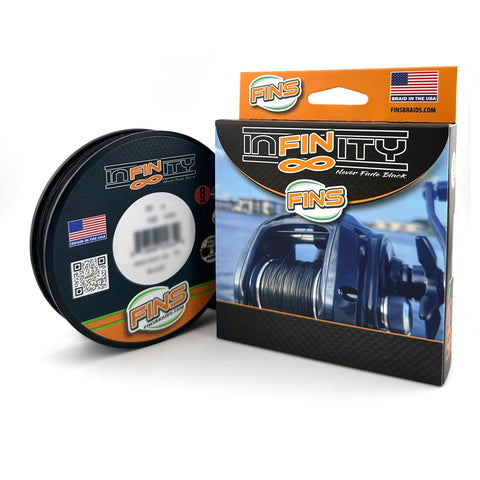Frog fishing has become a cornerstone technique in the pursuit of bass, offering a thrilling angle on traditional angling methods. This distinct approach takes advantage of the natural ecosystem, where the frog serves as a quintessential prey for bass, especially in weedy or lily-pad-infested waters.
Anglers who master the art of frog fishing are often rewarded with the excitement of explosive topwater strikes and the potential for catching trophy-sized bass. It is an adrenaline-pumping experience that not only requires skill but also offers an intimate understanding of bass behavior and habitat.
In this article, you'll learn the basics of frog fishing for bass and how you can use this technique to your advantage in your next fishing trip.
Choosing the Right Frog Lure
When delving into the world of frog lures, anglers are presented with a variety of options, each designed to mimic the movement and appearance of real frogs. The two primary types are hollow-bodied frog lures and soft-bodied frog lures.

Hollow-bodied lures, made of soft plastic, have a cavity that allows them to float on the water's surface. This design is perfect for topwater fishing, making them ideal for luring bass from their cover. Soft-bodied frog lures, on the other hand, are usually full of dense rubber or silicone, allowing for sub-surface fishing and a more weedless presentation.
Performance-wise, hollow-bodied frogs are exceptional during the warm months when bass are active and hunting in the shallows. They are especially effective in areas with heavy vegetation since their weedless design prevents snagging.
When selecting a quality frog lure for bass fishing, tackle aficionados should prioritize a few key features that make a substantial difference in their angling success. Lures should have a lifelike appearance and colors that closely resemble the frogs in the fishing environment. The durability of the material is essential, as frog lures often endure the abuse of frequent strikes and vegetation-heavy habitats.
Best Techniques for Frog Fishing
Topwater frog fishing requires mastery of technique and precision. A popular tactic is the "walk the dog" method, where the angler imparts a side-to-side motion to the lure by twitching the rod tip, mimicking a frog's erratic movement on the water's surface. This rhythmic action, combined with brief pauses, triggers an aggressive response from bass, resulting in explosive surface strikes.
Another effective strategy is to cast the lure near thick cover, such as lily pads, logs, or overhanging vegetation where bass tend to hide. Allowing the frog lure to sit motionless for a few seconds before beginning the retrieve can often tempt a cautious bass to bite. When a bass strikes wait a beat before setting the hook to ensure the fish has fully taken the lure.
Timing is a crucial element in the art of frog fishing for bass. Daybreak and dusk often provide the best opportunities, as bass are most active during these low-light conditions and more likely to strike at surface lures.
Weather conditions also have a big effect on frog fishing. Overcast skies can extend the prime fishing hours, with bass feeling more secure to roam and hunt without the bright glare of the sun piercing through the water. High temperatures in the summer months can warm the shallows, stimulating the bass' metabolism and increasing their predation.
The Best Rig Setup
The ideal rig setup for frog fishing is all about creating a system that allows the angler to cast precisely, maneuver the frog effectively, and handle the intense action following a strike. One of the most important parts of this setup is the fishing line.
Since frog fishing often occurs in areas dense with underwater brush and heavy cover, it's essential to use a line that can cut through the vegetation. Braided lines are the top choice for this purpose; their lack of stretch and superior strength make them ideal for pulling bass out of the thickest cover without breaking.
What's the Best Line for Frogging Bass?
FINS Infinity line is acclaimed for its quiet passage through reeds, a critical factor when stealthily targeting bass in their natural cover. Infinity's smooth, supple composition contributes to less disturbance, allowing the frog lure to navigate seamlessly amidst the reeds. Less noise translates to a higher chance of not spooking the fish, creating more opportunities for you to lure a bass into striking.
The FINS Pitch Black line is engineered for anglers who prioritize direct combat with the dense underwater jungles of freshwater habitats. Its dark hue makes it virtually invisible to fish, serving the dual purpose of being both stealthy and effective in slicing through vegetation.
Casting and Retrieval Tips
Strategies for effective frog lure casting revolve around accuracy and the ability to place your lure precisely where the bass are likely to be hiding. Anglers should practice casting to targets with pinpoint precision.
Getting the frog lure to land gently onto lily pads or strategically beside logs and overhangs can be decisive for success. It's advantageous to cast past the target and bring the lure into position with a controlled retrieve.
Retrieval is just as important as a good cast and involves making the lure dance on the spot, using gentle rod twitches to create small ripples that mimic a frog's natural behavior. Intermittently allowing the frog to remain stationary can also give the appearance of a live frog resting or sunning itself.
In more aggressive retrieval methods, rapid movement can trigger the predatory instincts of bass lying in ambush. This includes a steady retrieve interrupted by sudden bursts of speed or altering the direction of the lure to imitate a frog attempting to escape.
Location and Habitat Considerations
Bass often seek refuge and hunting grounds among thick aquatic vegetation like lily pads, hydrilla, and milfoil. These areas provide ample cover for bass to ambush prey and protect themselves from predators, making them an ideal place to target with frog lures.
Overhanging trees and submerged logs serve as prime bass real estate due to their shady protection and the accumulation of smaller fish that bass feed on. Pockets of open water surrounded by dense mats of vegetation are also veritable hotspots for frog fishing.
These secluded areas often go unnoticed by less observant anglers, yet they are havens where bass can breach the surface undetected to feed on frogs. Cast your lure to these pockets and work them thoroughly.
Shallow bays and coves with a mix of vegetation and wood structures also hold potential, especially during the warmer months when bass are more likely to be found in the shallow periphery. Always watch for any movement or disruption in the water, as this could indicate bass activity beneath the surface and an optimal location to cast your frog lure.
Seasonal Strategies
Spring sees bass move into shallow waters to spawn, and this presents a golden opportunity for topwater frog strategies. During this period, focus on areas with emerging vegetation and warming waters, and use slower, more deliberate movements to tempt the protective bass.
As summer unfolds, the emphasis shifts to early morning and late evening periods when bass are more active due to cooler temperatures. Frog lures worked across the thick mats and vegetative cover can entice bass seeking shelter from the midday sun. Summer also calls for more aggressive retrieval patterns to mimic a frog's natural vitality during these warmer months.
The pre-spawn and spawn periods in the spring, generally from late February through May, depending on the region, are prime times. During these months, the bass are in shallow water for spawning and are particularly defensive of their territory.\
Moving into fall, the period often referred to as the “fall feed-up,” which transpires from September to November, can also yield rewarding catches. This is when bass are fervently preparing for the lean winter months, aggressively feeding to store energy.
Additional Considerations Frog Fishing for Bass
Wind surprisingly influences frog fishing significantly; a light breeze can help create natural movements in the lure, making the frog imitation more convincing. However, strong winds may hamper casting accuracy and make it difficult to control the lure's retrieval.
Another critical factor is the frog lure's color. While there’s a range of colors available, each has its place and time. Generally, natural green and brown patterns are effective in clear waters, where bass can closely inspect the lure. In murkier waters, brighter colors or ones that provide high contrast can make the lure more visible and attractive to bass.
Even the sound of the frog lure can play a pivotal role in capturing the attention of bass. Different designs generate unique disturbances on the water's surface, from subtle plops to more pronounced splashing. Depending on the situation, you might opt for a quieter lure, which is less likely to startle bass in calm or heavily pressured waters.
Lastly, the timing of the frog lure’s introduction into a prospective fishing spot is also a strategic consideration. Instead of immediately casting upon arrival, it can be beneficial to observe the area’s characteristics and bass behavior. Patience can reveal the patterns of active bass, the locals' favored spots, and even the type of foraging available to the fish.
Perfecting Frog Fishing for Bass
The art of frog fishing for bass encompasses a blend of precision, patience, and an understanding of the aquatic environment. Mastery of casting techniques, retrieval rhythms, and habitat selection can exponentially increase your success rate. Get your perfect frog line by shopping at FINS Braids, where you'll find the right braid for any situation in every fishery.
Still not sure what braid is right for you? Try the FINS Braidfinder Quiz.




